| Solve Inequalities | |
How do you solve a linear inequality and sketch the solution on a number line?
|
How do you solve an absolute value inequality and sketch the solution on a number line?
|
| Investigation | |
| Graphic Organizer | |
| Notes | |
| Practice | |
| Application/Extension | |
| Online Extra Practice |
|
| Textbook Video Tutorials | |
| Regents Prep Text Tutorials | |
| OtherTutorials |
carlisleschools.org
Operations on Complex Numbers
Complex numbers are "binomials" of a sort, and are added, subtracted, and multiplied in a similar way. (Division, which is further down the page, is a bit different.) First, though, you'll probably be asked to demonstrate that you understand the definition of complex numbers.
- Solve 3 – 4i = x + yi Finding the answer to this involves nothing more than knowing that two complex numbers can be equal only if their real and imaginary parts are equal. In other words, 3 = x and –4 = y.
- Simplify (2 + 3i) + (1 – 6i).
- (2 + 3i) + (1 – 6i) = (2 + 1) + (3i – 6i) = 3 + (–3i) = 3 – 3i
- Simplify (5 – 2i) – (–4 – i).
- (5 – 2i) – (–4 – i)
- = (5 – 2i) – 1(–4 – i) = 5 – 2i – 1(–4) – 1(–i)
= 5 – 2i + 4 + i= (5 + 4) + (–2i + i)
= (9) + (–1i) = 9 – i
- Simplify (2 – i)(3 + 4i).
For the last example above, FOILing works for this kind of multiplication, if you learned that method. But whatever method you use, remember that multiplying and adding with complexes works just like multiplying and adding polynomials, except that, while x2 is just x2, i2 is –1. You can use the exact same techniques for simplifying complex-number expressions as you do for polynomial expressions, but you can simplify even further with complexes because i2 reduces to the number –1.
Adding and multiplying complexes isn't too bad. It's when you work with fractions (that is, with division) that things turn ugly. Most of the reason for this ugliness is actually arbitrary. Remember back in elementary school, when you first learned fractions? Your teacher would get her panties in a wad if you used "improper" fractions. For instance, you couldn't say " 3/2 "; you had to convert it to "1 1/2". But now that you're in algebra, nobody cares, and you've probably noticed that "improper" fractions are often more useful than "mixed" numbers. The issue with complex numbers is that your professor will get his boxers in a bunch if you leave imaginaries in the denominator. So how do you handle this?
Suppose you have the following exercise: Copyright © Elizabeth Stapel 2000-2011 All Rights Reserved
Adding and multiplying complexes isn't too bad. It's when you work with fractions (that is, with division) that things turn ugly. Most of the reason for this ugliness is actually arbitrary. Remember back in elementary school, when you first learned fractions? Your teacher would get her panties in a wad if you used "improper" fractions. For instance, you couldn't say " 3/2 "; you had to convert it to "1 1/2". But now that you're in algebra, nobody cares, and you've probably noticed that "improper" fractions are often more useful than "mixed" numbers. The issue with complex numbers is that your professor will get his boxers in a bunch if you leave imaginaries in the denominator. So how do you handle this?
Suppose you have the following exercise: Copyright © Elizabeth Stapel 2000-2011 All Rights Reserved
- Simplify

- This is pretty "simple", but they want me to get rid of that i underneath, in the denominator. The 2in the denominator is fine, but the i has got to go. To do this, I will use the fact that i2 = –1. If I multiply the fraction, top and bottom, by i, then the i underneath will vanish in a puff of negativity:
- Simplify

- If I multiply this fraction, top and bottom, by i, I'll get:


purplemath.com
No comments:
Post a Comment